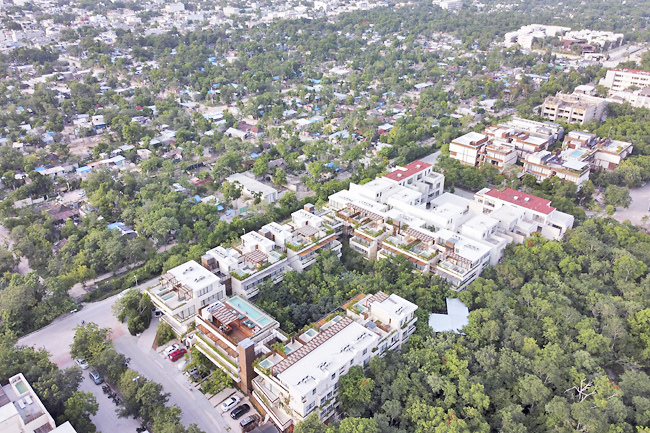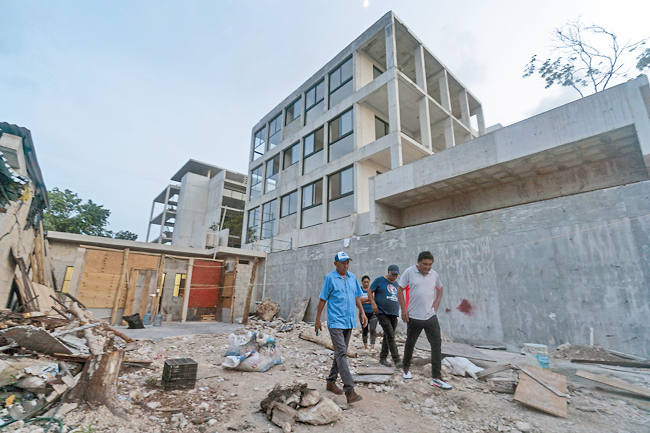Mark Stevenson
TULUM, MEXICO (AP) – Unchecked development has hit this once laid back beach town on Mexico’s Caribbean coast so hard that developers are now eager – even desperate – to build condominiums and hotels in a shantytown.
While police are trying to evict squatters so towering condos can be built next to wood and tarpaper shacks, residents are fighting back, saying they are tired of foreign investors excluding local people from their own coast.
In the latest clash on July 27, police accompanying a backhoe fired tear gas and tried to knock down some squatters’ homes in the shadow of a new, balconied condo building. The attempt ended when wind shifted the gas back on to officers, who retreated under a hail of rocks.
The contrast between rich and poor is stark: Gleaming four-storey condos with vaguely Mayan-sounding names and English slogans like ‘Live in the Luscious Jungle’ and ‘An immersive spiritual experience’ stand next to shacks made of poles, packing crates, tarps and tin roofing.
On a coast where unchecked resort development has already closed most public access to beaches – there are only a few public access points on the 130-kilometre stretch known as the Riviera Maya – residents of the squatters’ camp may have reason to ask whether poorer Mexicans will be allowed there at all.


Officials in Quintana Roo state have vowed to relocate or remove about 12,000 inhabitants of the 340-acre October 2 settlement. It was founded in 2016 on very valuable and once-public land a few blocks off the main street in town and about two kilometres from the shore.
Such land invasions are common across Mexico. Many are quickly rooted out. But others gradually become integrated into their cities. As many as 250,000 people are believed to live in squatter communities on the outskirts of Cancun.
Officials claim the “invaders” created a semi-lawless enclave that has worsened Tulum’s reputation for growing violence and threatened the vital tourism industry.
Squatter leader Jose Antonio León Méndez, a welder who has lived in Cancun and Tulum for about three decades, said he – like many of the squatters who work as cooks, gardeners and bricklayers at surrounding condos and hotels – was tired of knowing he could never afford a home in towns increasingly filled with foreigners.
“How can a Mexican be an ‘invader’ in his own country? That makes no sense. It’s like saying someone is stealing something that belongs to him,” said León Méndez. “These people are not thieves; they are Tulum’s workforce.”
“We do not have any personal problems with the foreigners, but they should respect our rights,” he said, adding that October 2 represents a last stand for Mexicans being priced out of their own coast.
The settlement is part of a larger, 500-acre stretch of public land that was sold by city officials to largely foreign developers in the 2000s.
Condos on the edge of the camp – and some well inside it – now sell for USD100,000 to USD150,000 and are advertised in US dollars – as are entrance fees at many seaside resorts. Around Tulum, USD20 per day is considered a good wage. So it would take decades of pay for the average Mexican worker to buy one.
The attorney general of Quintana Roo, Oscar Montes de Oca, vows to evict the squatters.
“We even have the court orders for eviction,” Montes de Oca said.
“It’s just that every time we have tried, they immediately get together and block the roads.”
Many of the roadblocks remain: mounds of stones, tyres and scrap wood piled in the streets, ready to be set alight.
Mateo Cruz, who rents a room for himself and his two children in the settlement, shows off the angry bruise on his thigh where he said he was hit by a police tear gas cannister.
“They came and said we had to get out, and take our things with us,” Cruz said of the July 27 attempted eviction. The lot where he lives sits directly under a new four-storey condo building.
“What were they thinking, firing tear gas among so many people?” Cruz said.
Montes de Oca said officials plan to relocate the squatters. “We are going to offer them lots away from this area, provided by the state government. The businessmen are going to contribute money to build houses.
“This is going to cause 70 per cent of these people to leave willingly, with the certainty of having a decent place to live,” Montes de Oca said. Asked what would be done about the other 30 per cent, he answered, “Other means will be applied.”
León Méndez rejects any such offer.
“We are not going to allow them to keep selling the land to foreigners while they send us locals, who have lived in Quintana Roo for 15, 20 or 30 years, to live 20 kilometres away in the woods,” he said.
“That is not negotiable.”
Given the cost of tourist-oriented taxis and bus lines, commuting from a new settlement could cost workers a quarter of their daily wages.
But officials have another argument.
Street-level drug dealing is behind many of the killings in the October 2 camp – just as it is in the rest of Tulum.
In October, two tourists – one a California travel blogger born in India and the other German – were caught in the apparent crossfire of rival drug dealers and killed at a restaurant along Tulum’s main avenue.
State Police Chief Lucio Hernández said government security cameras have detected that many of the drug dealers in Tulum use the squatters’ camp as a hideout.
Squatter leader Rafael Hernández Juárez acknowledges the area has become more violent, with drug sales and killings occurring every so often.
“We try not to get involved with them,” said the affable former tourist shuttle driver, noting it would be dangerous for him to report drug sellers.
Victor Reyes, a Tulum resident who works in real estate, estimates about 70 per cent of the investment in condominiums is from foreign developers, and the condos are priced in dollars “because they have to recover their investment in dollars”.
He reflects the suspicions some locals have about the squatters.
“Their groups became mafias,” Reyes said. “The organisations call people together… and they use women and children as cannon fodder” to avoid being evicted.
“They struck gold” by squatting on such valuable land, he said.
The squatters obviously are a political group – currently aligned with President Andrés Manuel López Obrador’s Morena party – and in a sense, many do see their humble shacks as striking gold.
Many have built second sets of rooms and rent their original shacks to locals. Some squatters have sold their roomy 10 by 20-metre lots for USD8,000 to USD12,000.
Seemingly all of them are investing whatever money they have in building rooms – sometimes brick, sometimes wood – incrementally, as they save up enough for materials.
But none have running water or sewer connections, though the condos built in the same camp all do; some of the condos even have swimming pools. Squatters jury-rig their electricity connections and make do with wells and primitive septic tanks drilled hacked into the rocky soil, the combination of which is problematic.
For the vast majority of squatters, even though they are living on pricey real estate, daily life remains a struggle.
Lenin Solís Vega, a construction worker is building his own house one cement block at a time. He was evicted twice from previous lots in the settlement – one of them 20 metres from his current house and where a new condo building is scheduled to go up.
“Now they say, ‘Why are you building?’ and they want to kick us out,” he said. “But how? We’re Mexicans and we have nothing.”
Some of the squatters have even taken advantage of the richer neighbours, who come to buy cheap meals from residents.
Lorena, originally from Campeche state, spent years cooking for tourists in hotels and restaurants where she was once prohibited from speaking her native Maya language.
She asked that her last name not be used to avoid problems with authorities.
And since building her wood-and-tarp shack – she planted trees and built a goldfish pond in the back – she has been able to set up her own street-food stand outside her house.
She has even learned to recite in English the menu of “beef, chicken” empanadas she sells to tourists who wander in from the condos.
“All the investors are welcome,” said Lorena, “but they can’t discriminate or look down on us just because we are poor.”





